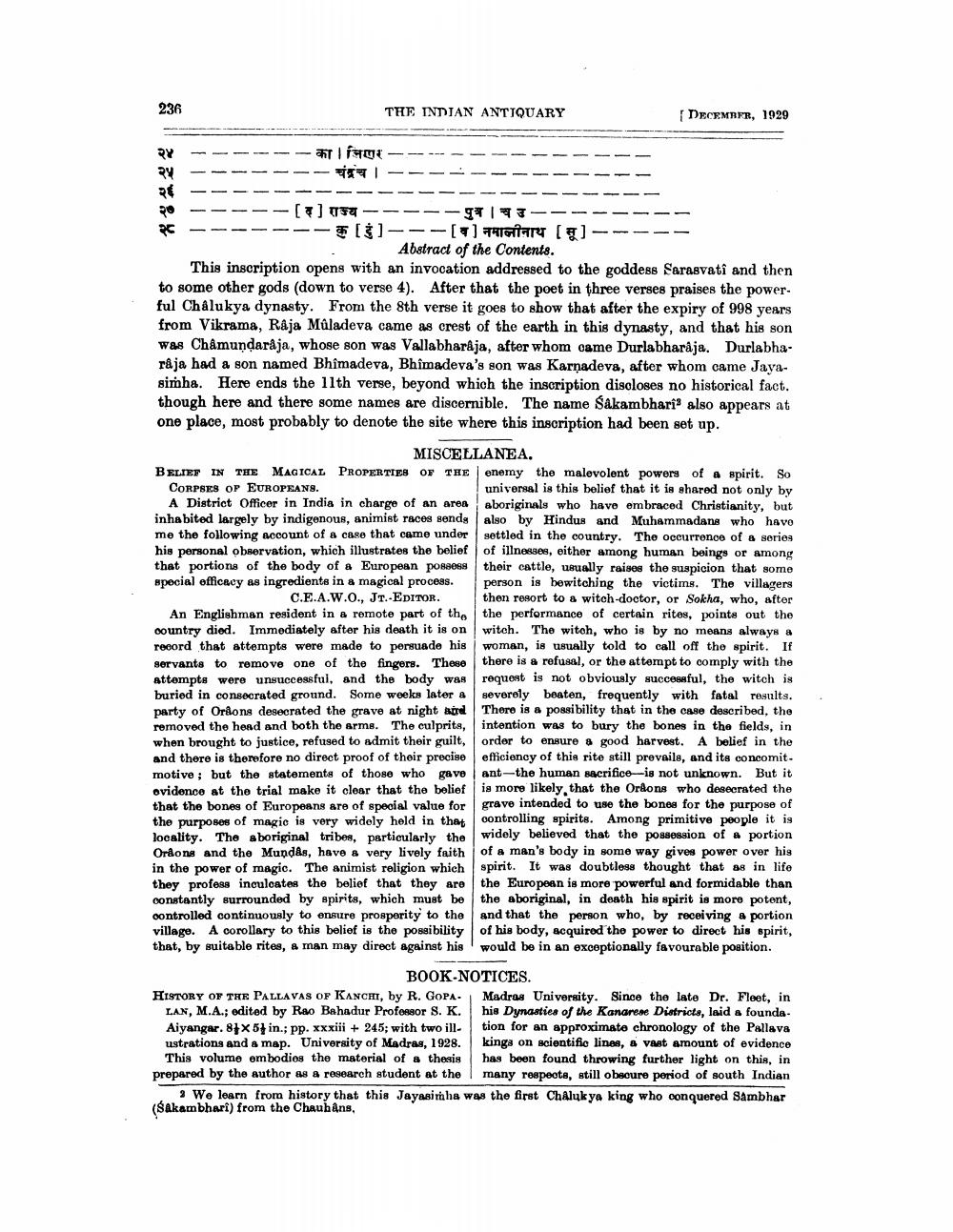________________
THE INDIAN ANTIQUARY
DECEMRFR, 1929
- U - - - - - -
- - - - - -
- - - - - - - - - - - - - - - - - - - - - - - - - - - [+] T4 -----973 --- - -- -- - --- [$]---[] THAT ( -- - - -
Abstract of the Contents. This inscription opens with an invocation addressed to the goddess Sarasvati and then to some other gods (down to verse 4). After that the poet in three verses praises the power. ful Chalukya dynasty. From the 8th verse it goes to show that after the expiry of 998 years from Vikrama, Raja Mûladeva came as crest of the earth in this dynasty, and that his son was Châmundard ja, whose son was Vallabharâja, after whom came Durlabharaja. Durlabharája had a son named Bhimadeva, Bhimadeva's son was Karnadeva, after whom came Jayasimha. Here ends the 11th verse, beyond which the inscription disoloses no historical fact. though here and there some names are discernible. The name Sakambhari' also appears at one place, most probably to denote the site where this inscription had been set up.
MISCELLANEA. BELIEF IN THE MAGICAL PROPERTIES OF THE enemy the malevolent powers of a spirit. So CORPSES OP EUROPEANS.
universal is this belief that it is shared not only by A District Officer in India in charge of an area aboriginals who have embraced Christianity, but inhabited largely by indigenous, animist races sendo also by Hindus and Muhammadane who have me the following account of a case that came under settled in the country. The occurrence of a series his personal observation, which illustrates the belief of illnesses, either among human beings or among that portion of the body of a European posess their cattle, usually raises the suspicion that some special officacy as ingredients in a magical process. person is bewitching the victims. The villagers
C.E.A.W.O., JT.-EDITOR. then resort to a witch-doctor, or Sokha, who, after An Englishman resident in a remote part of the the performance of certain rites, points out the country died. Immediately after his death it is onwitch. The witch, who is by no means always a record that attempts were made to persuade his woman, is usually told to call off the spirit. If servants to remove one of the fingers. These there is a refusal, or the attempt to comply with the Attempts were unsuccessful, and the body was request is not obviously succesful, the witch is buried in consecrated ground. Some weeks later a severely beaten, frequently with fatal results. party of Orlona desecrated the grave at night and There is a possibility that in the case described, the removed the head and both the arms. The culprits, intention was to bury the bones in the fields, in when brought to justice, refused to admit their guilt, order to ensure a good harvest. A belief in the and there is therefore no direct proof of their precise efficiency of this rite still prevaile, and its concomit. motive ; but the statements of those who gave ant-the human sacrifice is not unknown. But it ovidence at the trial make it clear that the belief is more likely that the Ordons who desecrated the that the bones of Europeans are of special value for grave intended to use the bones for the purpose of the purposes of magie is very widely held in that controlling spirits. Among primitive people it is locality. The aboriginal tribes, particularly the widely believed that the possession of portion Ordone and the Mundas, have a very lively faith of a man's body in some way gives power over his in the power of magic. The animist religion which spirit. It was doubtless thought that as in life they profess inculcates the belief that they are the European is more powerful and formidable than constantly surrounded by spirits, which must be the aboriginal, in death his spirit is moro potent, controlled continuously to ensure prosperity to the and that the person who, by receiving a portion village. A corollary to this belief is the possibility of his body, acquired the power to direct his spirit, that, by suitable rites, a man may direct against his would be in an exceptionally favourable position.
BOOK-NOTICES. HISTORY OF THE PALLAVAS OF KANCHI, by R. GOPA. Madras University. Since the late Dr. Fleet, in
LAN, M.A.; edited by Rao Bahadur Professor S. K. his Dynasties of the Kanarere Districts, laid a foundaAiyangar. 87 x 5 in.; pp. xxxiii + 245; with two ill- tion for an approximate chronology of the Pallava ustrations and a map. University of Madras, 1928. kinga on scientific lines, & vast amount of evidence
This volume em bodies the material of a thesis has been found throwing further light on this, in prepared by the author as a research student at the many respecte, still obecure period of south Indian
* We learn from history that this Jayasimha was the first Chalukya king who conquered Sambhar (Sakambhari) from the Chauhans,




